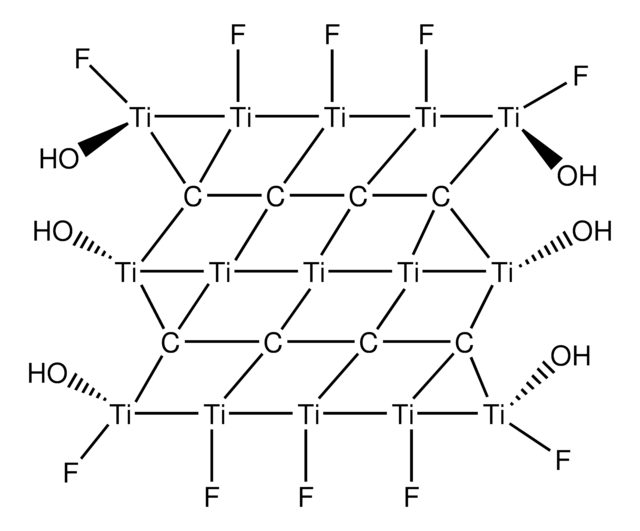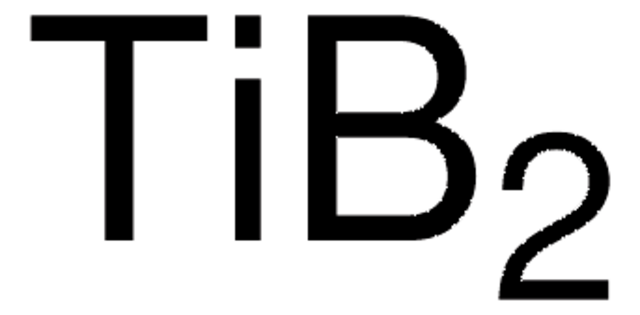Products may be shipped at a different temperature than the recommended long-term storage temperature. If the product quality is sensitive to short-term exposure to conditions other than the recommended long-term storage, it will be shipped on wet or dry-ice. If the product quality is NOT affected by short-term exposure to conditions other than the recommended long-term storage, it will be shipped at ambient temperature. As shipping routes are configured for minimum transit times, shipping at ambient temperature helps control shipping costs for our customers. For more information, please refer to the Storage and Transport Conditions document: https://www.sigmaaldrich.com/deepweb/assets/sigmaaldrich/marketing/global/documents/316/622/storage-transport-conditions-mk.pdf
636967
Titanium carbide
nanopowder, ≤200 nm particle size (SEM)
Synonyme(s) :
Titanium(IV) carbide
Sélectionner une taille de conditionnement
Sélectionner une taille de conditionnement
About This Item
Produits recommandés
Forme
nanopowder
Taille des particules
≤200 nm (SEM)
pb
4820 °C (lit.)
Pf
3140 °C (lit.)
Densité
4.930 g/mL at 25 °C (lit.)
Masse volumique apparente
0.45 g/mL
Chaîne SMILES
[C-]#[Ti+]
InChI
1S/C.Ti/q-1;+1
Clé InChI
YXIVWSJCLXKLJL-UHFFFAOYSA-N
Vous recherchez des produits similaires ? Visite Guide de comparaison des produits
Catégories apparentées
Application
- Conductive two-dimensional titanium carbide ′clay′ with high volumetric capacitance: This study demonstrates the high volumetric capacitance of titanium carbide (Ti3C2) films, which are produced by etching aluminum from titanium aluminum carbide (M Ghidiu et al., 2014).
- Unique lead adsorption behavior of activated hydroxyl group in two-dimensional titanium carbide: The research highlights the lead adsorption capabilities of 2D titanium carbide due to activated hydroxyl groups (Q Peng et al., 2014).
- Transparent, flexible, and conductive 2D titanium carbide (MXene) films with high volumetric capacitance: This article describes the synthesis and properties of transparent and flexible 2D titanium carbide films, which exhibit high volumetric capacitance (C Zhang et al., 2017).
Code de la classe de stockage
11 - Combustible Solids
Classe de danger pour l'eau (WGK)
WGK 1
Équipement de protection individuelle
Eyeshields, Gloves, type N95 (US)
Faites votre choix parmi les versions les plus récentes :
Déjà en possession de ce produit ?
Retrouvez la documentation relative aux produits que vous avez récemment achetés dans la Bibliothèque de documents.
Les clients ont également consulté
Articles
Among various ceramics, one-dimensional (1-D) piezoelectric ceramics have attracted significant scientific attention for use in energy harvesting.
-
How is shipping temperature determined? And how is it related to the product storage temperature?
1 réponse-
Utile ?
-
-
How can I determine the shelf life / expiration / retest date of this product?
1 réponse-
If this product has an expiration or retest date, it will be shown on the Certificate of Analysis (COA, CofA). If there is no retest or expiration date listed on the product's COA, we do not have suitable stability data to determine a shelf life. For these products, the only date on the COA will be the release date; a retest, expiration, or use-by-date will not be displayed.
For all products, we recommend handling per defined conditions as printed in our product literature and website product descriptions. We recommend that products should be routinely inspected by customers to ensure they perform as expected.
For products without retest or expiration dates, our standard warranty of 1 year from the date of shipment is applicable.
For more information, please refer to the Product Dating Information document: https://www.sigmaaldrich.com/deepweb/assets/sigmaaldrich/marketing/global/documents/449/386/product-dating-information-mk.pdfUtile ?
-
Filtres actifs
Notre équipe de scientifiques dispose d'une expérience dans tous les secteurs de la recherche, notamment en sciences de la vie, science des matériaux, synthèse chimique, chromatographie, analyse et dans de nombreux autres domaines..
Contacter notre Service technique













